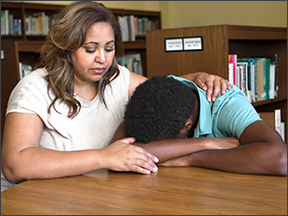Part 1 of a four-part series on how SEL and great academics support each other
Last summer, when Pete and our colleague Tonia Gibson visited Liberty Union High School District in Brentwood, California, the changes from the old normal were impossible to miss:
Student achievement was down.
Student behavior issues were up.
Teacher stress was way, way up.
And this was despite the fact that leaders in the five-campus district had, wisely, eased up on such external motivators as high-stakes testing. The teachers were being tough on themselves because they profoundly felt the urgency of getting students back into healthy learning routines. The conditions that would make that possible, however, no longer existed, leading teachers into unwinnable conundrums like trying to teach two years’ content simultaneously. It was a clear reminder of the importance of social-emotional learning, and an equally clear reminder of why teachers grow wary when outside experts like us start talking about SEL: One more thing?
It’s a familiar chicken-and-egg conundrum: Educators readily agree that there are preconditions to learning relating to a sense of safety and self-worth, and if those preconditions aren’t met, learning simply can’t happen. At the same time, teachers are paid to teach, and face pressure to stay in their lane. After two years of intermittent lockdowns, quarantines, masking, and school closures, this conundrum has only intensified. Many students do not appear to be ready to learn, yet teachers are pushing themselves to act as if they are, with predictably disappointing results.
So how do educators—many of whom are, themselves, feeling burned out and in need of emotional support—move forward? Moreover, is there any way to thrive, not just survive, in this current climate?
Fortunately, there is. And we don’t need to halt all instruction to tend to students’ social-emotional needs. Nor do we steam ahead with teaching while turning a blind eye towards students’ social and emotional needs. How do we do that?
By doing what great teachers have always done: provide challenging, engaging, and intentional instruction. In short, we can help students be well, by learning well—and vice versa. That is, we can use high-leverage teaching practices to create student-centered environments that support their social-emotional learning needs.
Defining student-centered practices
To explain how, let’s start by describing what we mean by student-centered learning environments. In his work in schools and districts nationwide with Kristin Souers, a licensed mental health counselor and childhood trauma expert, Pete has discovered, over and again, that five key attributes of healthy classrooms before the pandemic grew even more essential during the pandemic, and thus can be expected to remain crucial in the years to come:





Collectively, these five attributes help to paint a compelling and straightforward picture of what a student-centered, socially-emotionally competent classroom looks like.
So, do teachers have to stop everything and construct these learning environments? Not at all. As it turns out, we can create such environments by applying practical, evidence-based teaching practices—many of which are already familiar to many teachers and likely in their current repertoire of teaching techniques. We’ll dive into them in the next installment.

Pete Hall, the executive director of Education Hall, taught preK–8 in three states, then served as a principal for 12 years in three Title I schools. He’s the author or co-author of many works on teaching and learning, including McREL’s A Teachers’ Reflective Impact Journal: Pursuing Greatness Every Day, as well as the YA novel Chasing the Show.


